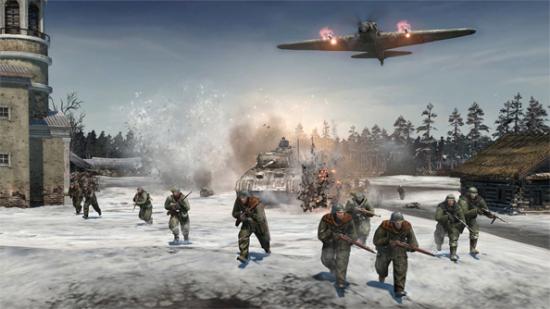Company of Heros 2 has been released; read our Company of Heroes 2 review to find out our verdict.
I’m only playing a demonstration level of the sequel to Relic’s World War 2 RTS, so I appreciate that it’s going pretty easy on me. It’ll be generous to me whenever I make a mistake because it has all sorts it wants to show off. Still, it feels all too apt that, every time I screw up and get another of my Soviet squads killed, the game just sends another one forward to replace it. I guess success comes at any price.
It’s been a long six years since we saw the first Company of Heroes and, to be honest, I’d expected the sequel to look quite different. That’s not to say I’m disappointed. The whole experience is immediately familiar, a bit like settling into a favourite chair and knowing everything is in reach: the bowl of nuts, the TV remote, that button you press to lob grenades at nearby Nazis.
Still, I wanted everything to be a little bit shinier, to have a little more pizazz, and while the graphics are a little sharper and the dynamic environments a little more, uh, dynamic, there’s no great leap forward here, just a fresh lick of paint. Instead, Relic assure us that most of the significant changes lurk below the surface of this sequel, and have a subtle but significant impact on the game.
Take, for example, the environmental effects. As I send a squad of combat engineers forward, their flamethrower drenches a nearby building in burning petrol. The dense cloud of smoke that begins to rise cuts off my line of sight and I now can’t tell if troops are escaping out the back door. This is how the new TrueSight mechanic works, drawing lines of sight from every one of your troops and calculating what they can and can’t see on the battlefield. The fog of war just got thicker.
If the wind changes, then that smoke moves with it, gradually obscuring a different section of the map and potentially affecting my ability to understand what is happening on this battlefield. If either me or my opponent rely on the smoke for cover, both of us need to remember that we could lose that benefit at any moment.
Sending my soldiers forward, I notice that they’re now more inclined to leap over low cover rather than waste time skirting around it, a perfectly logical change, and as they sprint for some sandbags I find myself thinking about all those tracks that they’re leaving in the snow. Some spiral their way towards where my troops are now, crouched and carefully returning fire at the Nazis that they’ve cornered in a farmhouse. But not all those tracks are mine. Some are clues to my opponent’s movements and I need to keep an eye on the ground to try and guess where enemy soldiers and vehicles might be found.
Sadly, the demo is all too short and after a couple of brief firefights, I’ve had only the most cursory of introductions to these new elements. I don’t get to witness any fresh snowfall, to use grenades to break ice and sink tanks into freezing water or, most importantly, see exactly how the AI makes use of these environmental effects. Clearly, Company of Heroes 2 has the potential to be a very crafty sequel indeed, with details like these having profound implications for multiplayer games, but I want to see how well a computer opponent handles them.
Scheduled for release in early 2013, the game will be entering beta fairly soon. I’ve secured a spot and, just as soon as I can, I’ll be rigorously testing that AI, as well as seeing if I can get my soldiers to lay down and make snow angels. In the meantime, look out for my forthcoming interview with Relic.
